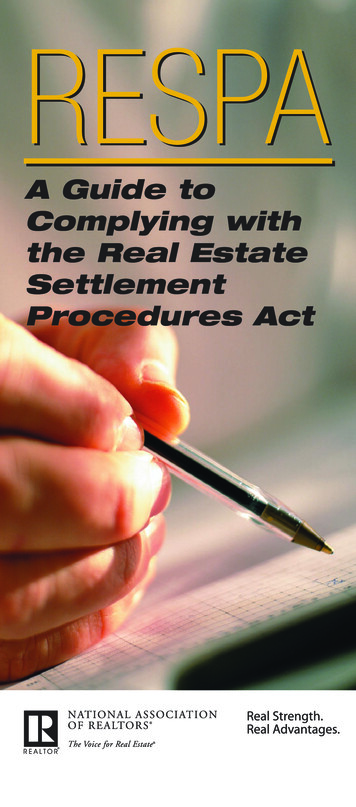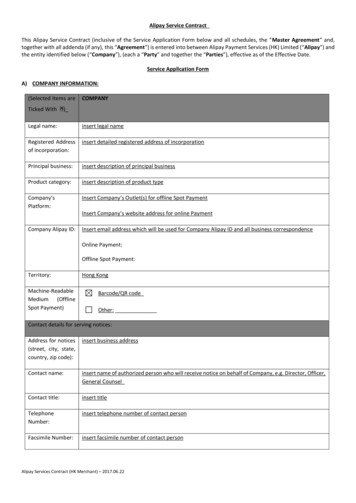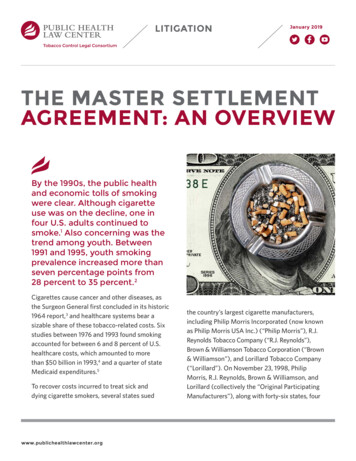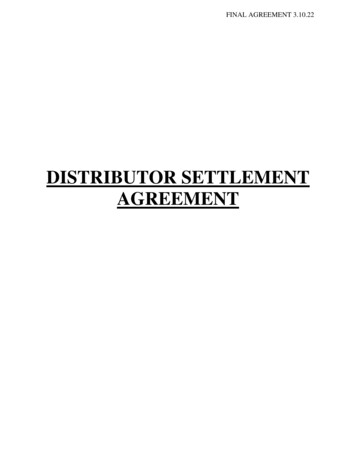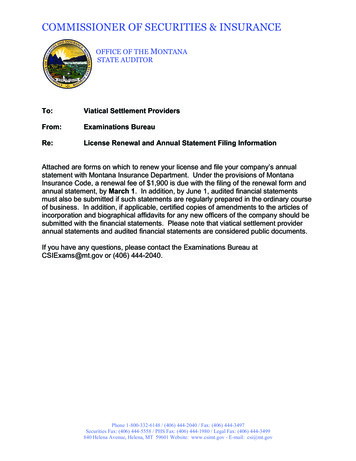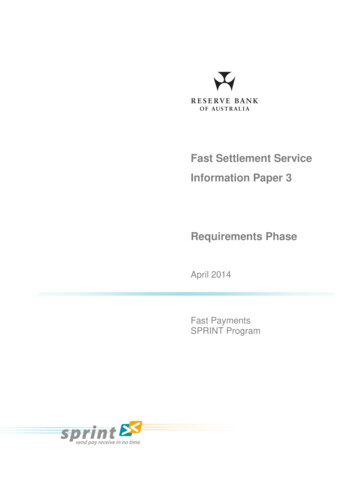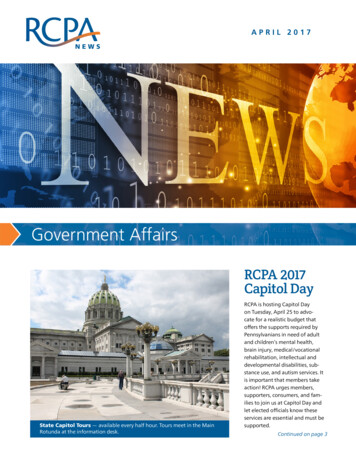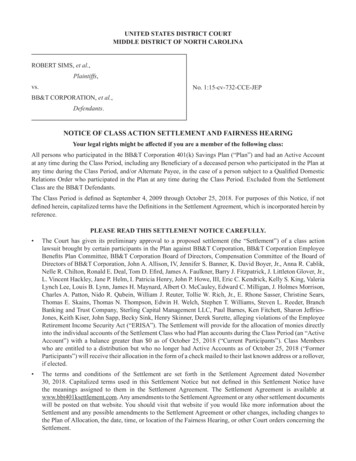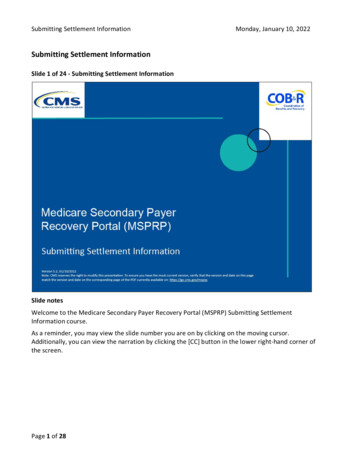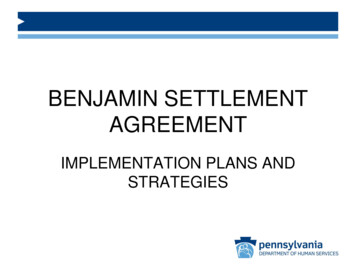
Transcription
BENJAMIN SETTLEMENTAGREEMENTIMPLEMENTATION PLANS ANDSTRATEGIES
WHAT IS THE BENJAMIN SETTLEMENT AGREEMENT? In April 2009, the Department of Human Services (DHS) was subjectto the Benjamin lawsuit, which alleged that individuals with anintellectual disability were unnecessarily segregated in stateoperated ICFs/ID in violation of the Americans with Disabilities Act. The nature of the alleged segregation was that the Departmentfailed to offer ICF/ID residents placement in a community setting. The court ruled in favor of the Plaintiffs and a settlementagreement on the remedy was reached in June 2011. The settlement agreement was subsequently vacated by the ThirdCircuit Court in December 2012 in response to a legal challengefrom a group of ICF/ID residents who claimed that the settlementrequirements were contrary to their wishes. A new settlement agreement developed by and agreed upon by allparties was signed in June 2014. The court approved the settlementagreement in September 2014.
SETTLEMENT OVERVIEW The settlement requires that the Department’s Office of Developmental Programs(ODP) take measures to protect individual choice and facilitate transition tocommunity residence for those who so choose. Some of these measures include: Ensuring that each individual residing in a state-operated ICF/ID who has thecapacity to make an informed choice and expresses a preference forcommunity living will move to the community; Ensuring that everyone who is capable of making a choice about where he orshe lives may make a choice at any time; Committing to respecting the wishes of individuals, legal guardians, andsubstitute decision makers who decide to continue residency at a stateoperated ICF/ID and honoring their choice of living arrangement; Committing to maintain the level of care currently provided to individualsresiding in a state-operated ICFs/ID, and assure that the state ICFs/ID continueto meet the criteria needed to protect the health, welfare, and safety ofindividuals, and to provide them with active treatment.
SETTLEMENT OVERVIEW Transitioning at least 80 individuals to the community by June 30, 2015,50 individuals to the community between July 2015 and June 2016,50 individuals to the community between July 2016 and June 2017, and50 individuals to the community between July 2017 and June 2018 If at any time there are fewer individuals on the planning list than thenumber of individuals slated to move in the agreement, the Departmentwill work to move only the number of individuals remaining on the list. Creating a website that allows providers to view information aboutindividuals who chose to transition to the community and to notify ICF/IDstaff of their potential interest in serving an individual; and Monitoring community transition to ensure positive outcomes, includingprevention of arrests or unnecessary readmissions to ICFs/ID.
CURRENT STATUS As of January 15: 46 class members have moved to the communitysince the original settlement agreement; There are 64 class members on the Planning Listtoday; Of the 64, 6 class members have projected transition dates betweenJanuary – March, 2016; 6 have a provider selected but no home identified yet; 2 were recently added; 2 were added as a result of the Facility DirectorDeterminations; and 48 have no provider selected yet.
MOVING FORWARD The AE’s will manage the transition process with the cooperationand support of the Centers and ODP regional staff. SC services will begin very early in the transition process. The Provider Selection process will be enhanced. ODP has identified resources for new development. AE’s that transition 3 class members on the Planning List willreceive community match capacity. Tracking and reporting of transition milestones will be used tomeasure progress and identify barriers. An Implementation Team will oversee the transition process andprovide support to all parties [AE’s, Providers, SC’s, center staff,etc.].
ROLESBenjamin ClassMemberis placed on thePlanning ListSC reviewsrecordsClass MemberselectsProviderAE Lead provides ClassClass Member's choicecommunicated by StateCenter Transition Lead toRegional Lead andImplementation LeadRegional LeadnotifiesAE Leadwith information onselection of SCOSC/State CenterSocial ServicesschedulesELP/ISP meeting[s]AE informs classProvider[s] develop amemberand family of providerresponse plan to theclassoptionsmembers ISPSC and ISP TeamdevelopsClass Membermovestransition activitiesandschedule3/25/2016Member and/orGuardian7
ROLES 3/25/2016The community supports roles; Regional leads, AE Leads, SupportsCoordinator, and Providers will remain the same for the class memberswho are have a Transition Plan and a projected movement date.The AE will coordinate the transition of class members including trackingprogress and identification of obstacles and assist wherever necessary.It is preferred that the SC who will be providing supports after theindividual moves to the community could be engaged early in theplanning process to provide greater consistency and support beyond thetransition.For class members whose planning has not been initiated or who do notcurrently have a provider, the flowchart will be followed, with the keydifference being the roles of the AE Leads and Supports Coordinators.The SC will orchestrate the person centered planning activities, includingthe ELP and the ISP. These will supplement or substitute for the current‘1-page descriptions when providers are considering referrals.SC’s will coordinate with State Center Social Service staff to setmeetings, invitees, locations and transition planning and implementation.8
CURRENT BARRIERS MATCHING HOUSEMATES HOME MODIFICATIONS PROVIDER INTEREST
MILESTONESProgress will be tracked and measured on the followingmilestones* in the process that represent significantprogress in transition to the community: ELP completed Provider selected Home procured ISP/Transition Plan completed Projected transition date set* There are many interim steps that will be tracked also, however; the above milestones arepredictors of ultimate success.
PROVIDER OUTREACHThe Problem: Provider interest has been generated through their accessto the website that includes 1-page descriptions of classmembers on the Planning List. 75% of the class members on the Planning List have noprovider selected. Some class members have had noprovider interest expressed at all. Most responses from providers have been to fill vacanciesin existing homes. And some of these are removed due tocommunity emergencies. Limits on start-up funding and difficulty in identifyingcompatible housemates has resulted in limited newdevelopment.
PROVIDER OUTREACHThe Plan The Settlement Agreement requires that the 1-pagedescriptions are completed. However, when a newclass member is added to the Planning List, anEssential Lifestyle Plan [ELP] will be posted on thewebsite to give providers a more person centereddescription for their consideration. ODP will work with the counties to prompt provideroutreach. ODP will address start-up needs ODP will also provide Life Sharing resource andTraining opportunities
PROVIDER SELECTION ODP will develop standardized criteria for aProvider Response Plan. This plan must becompleted and presented to the classmember and team members for review andan opportunity for questions and follow-up. SC’s will have tools to assist class membersand families/guardians to review providerresponse plans and select among willing andqualified providers.
NEW HOME DEVELOPMENT ODP will not support single person homesunless the need is identified and justified inthe individual’s ISP. Twelve [12] counties/AEs have only one classmember identified. ODP will assist in strategizing how to findmatches for people and alliances to maximizeopportunities for development of grouphomes.
START-UP ODP will provide additional start-up monies tomeet the individualized needs of class membersbeing served in new homes. The start-up application process will be revised toinclude AE review and approval of provider requests. Additional start-up funds are limited to necessaryaccommodations for class members physical andhealth and safety needs.** Start-up does not include down payments on purchased homes.
Supports Coordination ODP is requesting that AE’s begin the SCO choice upon notification thata class member has been placed on the Planning List. For the 48 class members currently on the list with no providerselected yet, SCO’s shall be selected by March 15th. For the 16 class members on the Planning List with a provider selected,if not already done, SCO’s shall be selected by February 28th. Supports Coordinators will: Work with the Center Social Workers to identify a facilitator for theclass members’ ELPs. Initiate the ISP and lead team meetings. Finalize the transition plans. Coordinate transition visits.3/25/201616
EXPECTATIONSODP has developed expectations regarding timelines for implementation.These are guidelines, but will be used as measures to evaluate progress andalert the Implementation Team to any possible barriers or need fortroubleshooting. All class members on the current Planning List without a providerselected will have a provider selected by April 30, 2016. New class members placed on the Planning List will have a providerselected within 45 days of being placed on the list. Class members shall transition to the community within 3 months ofthe date a provider is selected if they are moving to an existing home. Class members shall transition to the community within 6 months ofthe date a provider is selected if they are moving into a new home. Class members shall transition to the community within 9 months ofthe date a provider is selected if the home requires building orrenovations.
TRACKING & REPORTING ODP has developed a tracking tool and protocolto use as day to day tracking as well as an At-AGlance report on the status of the milestones. AE’s will use the identical spreadsheets andprovide updates to Regional Leads for ODPupdates. Status updates will be sent by providers and AE’svia a dedicated mailbox.[RA-BenjaminImplmnt@pa.gov]
Benjamin Class Member’s Registration Counties112111113217111361923123/25/20161124212
NEXT STEPS ODP will provide each AE with updated information on classmembers on the Planning List and their status. In order to benefit from the allocation of community match, AE’s withfewer than 3 class members on the planning list should developalliances to explore shared efforts. AE’s that successfully identify alliances shall notify the RegionalBenjamin leads with their proposals. SC’s shall be assigned by February 28th for class members withproviders selected. SC’s shall be assigned by March 15th for class members with noprovider interest expressed.3/25/201620
CONTACT INFORMATION Regional Benjamin Leads: Southeast RegionNortheast RegionCentral RegionWestern RegionKathy AlstonTim LittleDenise SloandLaura lsippos@pa.gov Benjamin Implementation Lead Vicki Stillman-Toomeyvistillman@pa.gov Benjamin MailboxRA-pwbenjaminImplement@pa.gov3/25/201621
a class member has been placed on the Planning List. For the 48 class members currently on the list with no provider selected yet, SCO's shall be selected by March 15th. For the 16 class members on the Planning List with a provider selected, if not already done, SCO's shall be selected by February 28th. Supports Coordinators will:

